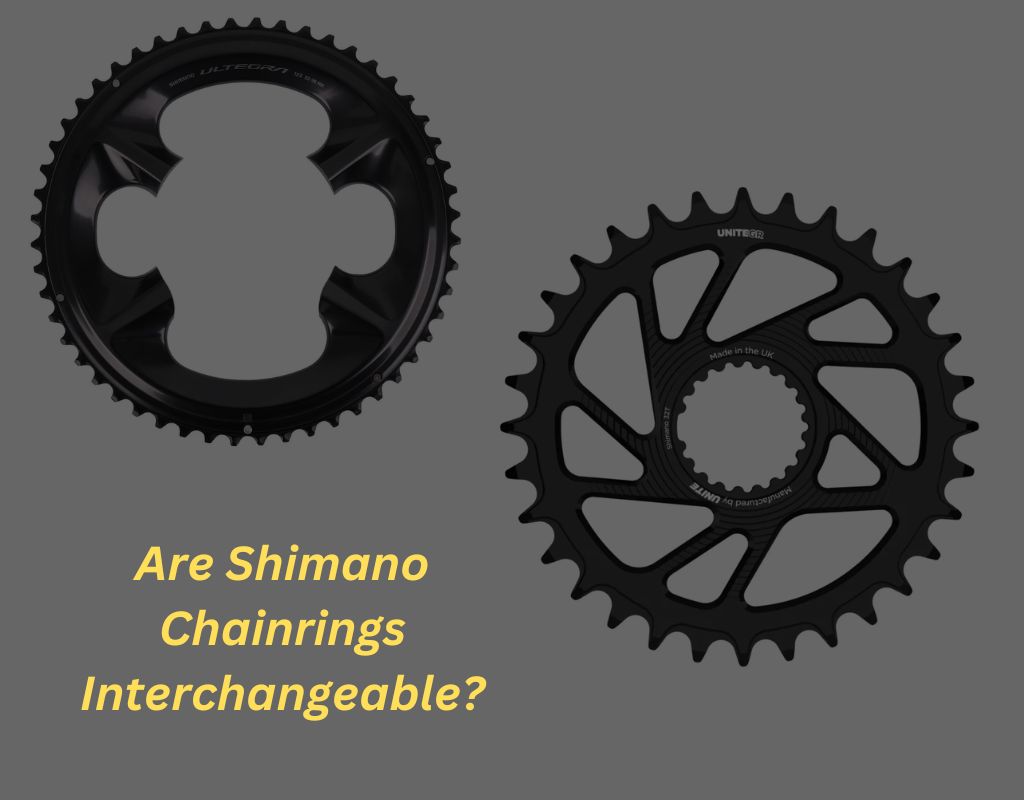
Shimano is one of the leading manufacturers of bicycle components, especially drivetrain parts such as chainrings, cranks, derailleurs, and cassettes. Shimano offers a range of groupsets for different types of bikes and riding styles, from entry-level to professional-level.
But are Shimano chainrings interchangeable among different groupsets and models?
The answer is not so simple, as there are several factors that affect the compatibility of chainrings.
Shimano Chainrings
A chainring is the toothed disc that attaches to the crank arm and drives the chain. Chainrings come in different sizes, shapes, and materials, depending on the intended use and performance.
Shimano chainrings are designed to work seamlessly with Shimano cranks, derailleurs, chains, and cassettes, to provide smooth and reliable shifting and pedaling.They are categorized by their bolt circle diameter (BCD), which is the distance between the center of the bolt holes that attach the chainring to the crank arm.
Shimano uses different BCDs for different groupsets and models, depending on the number of teeth, speed, and design of the chainring.
For example, Shimano road chainrings typically have a BCD of 110 mm or 130 mm, while Shimano mountain bike chainrings have a BCD of 64 mm or 104 mm.
Shimano chainrings are also designed with specific features to enhance their performance and compatibility with other components.
Some Shimano chainrings have ramps and pins that help guide the chain during shifting, while others have hollow or carbon construction to reduce weight and increase stiffness.
Related: Can You Mix SRAM and Shimano?
Factors Influencing Chainring Interchangeability
The interchangeability of Shimano chainrings depends on several factors, such as:
- The BCD of the crank arm and the chainring
- The speed of the drivetrain
- The shape and profile of the teeth
- The features and design of the chainring
- The compatibility with the front derailleur
The most important factor is the BCD of the crank arm and the chainring. The BCD must match exactly for the chainring to fit on the crank arm. A 110 mm BCD chainring will not fit on a 130 mm BCD crank arm, and vice versa.
Matching Drivetrain Speed
The speed of the drivetrain affects the interchangeability of Shimano chainrings. The speed of the chainring must match or be compatible with the speed of the cassette, chain, and derailleur.
A 10-speed chainring will not work well with a 12-speed cassette or chain, as they have different widths and shapes.
Teeth Shape and Profile
The shape and profile of the teeth influences the compatibility of Shimano chainrings. The shape and profile of the teeth must match or be compatible with the shape and profile of the chain links.
Features and Design
The features and design of the chainring must match or be compatible with the features and design of the crank arm and derailleur.
A hollow or carbon chainring will not fit well on a solid or aluminum crank arm.
Front Derailleur
The compatibility with the front derailleur impacts the interchangeability of Shimano chainrings. The front derailleur must be able to accommodate the size, shape, and position of the chainring.
For example, a front derailleur designed for a double-chainring setup will not work well with a triple-chainring setup.
Related: What is Shimano Ice Tech?
Interchangeability within Shimano Groupsets
Shimano groupsets are collections of components that are designed to work together as a system. Shimano offers several groupsets for different types of bikes and riding styles, such as Dura-Ace, Ultegra, 105, Tiagra, Sora, GRX, Deore, SLX, XT, and XTR. Each groupset has its own specifications, features, and performance levels.
Within each groupset, Shimano chainrings are generally interchangeable, as long as they have the same BCD, speed, and design.
A Shimano 105 FC-5700 chainring will fit on a Shimano 105 FC-5600 crank arm, as they have the same 130 mm BCD, 10-speed compatibility, and design.
There may be some exceptions or limitations to the interchangeability within Shimano groupsets. Some Shimano chainrings have different shapes or thicknesses where they meet the crank arm, which may affect the aesthetics or functionality of the chainring.
Cross-Series Compatibility
Cross-series compatibility refers to the interchangeability of Shimano chainrings across different groupsets or series. It is possible in some cases, but not in others.
The main factor that determines the cross-series compatibility of Shimano chainrings is the BCD of the crank arm and the chainring. If the BCD matches, then the chainring may fit on the crank arm.
Still, there are other factors that affect the cross-series compatibility of Shimano chainrings, such as:
- The speed of the drivetrain
- The shape and profile of the teeth
- The features and design of the chainring
- The compatibility with the front derailleur
A Shimano Ultegra FC-6700 chainring may fit on a Shimano 105 FC-5700 crank arm, as they have the same 110 mm BCD. They may not work well together, as they have different speeds (11-speed vs 10-speed), shapes (hollow vs solid), and designs (thicker vs thinner) of the chainring.
Therefore, cross-series compatibility of Shimano chainrings is not guaranteed or recommended by Shimano. It may work in some cases, but can also cause problems or compromise the performance of the drivetrain.
Related: Tiagra vs. GRX: A Comprehensive Comparison
Upgrading Chainrings and Compatibility
Upgrading chainrings is a common way to improve the performance or customize the gearing of a bike. However, upgrading chainrings also requires considering the compatibility of the new chainrings with the existing components.
The main factor that determines the compatibility of upgrading chainrings is the BCD of the crank arm and the new chainring. The BCD must match exactly for the new chainring to fit on the crank arm. If the crank arm has a 130 mm BCD, then only 130 mm BCD chainrings can be used.
There are factors that affect the compatibility of upgrading chainrings, such as:
- The speed of the drivetrain
- The shape and profile of the teeth
- The features and design of the new chainring
- The compatibility with the front derailleur
If upgrading from a 10-speed to an 11-speed chainring, then the cassette, chain, and derailleur must also be upgraded to 11-speed compatible models.
Also, if upgrading from a double-chainring to a triple-chainring setup, then the front derailleur must also be changed to a triple-compatible model.
Therefore, upgrading chainrings requires careful planning and research to ensure that all components are compatible and work well together.
Tips for Successful Chainring Compatibility
To ensure successful chainring compatibility, here are some tips to follow:
- Check the BCD of your crank arm and your desired chainring before buying or installing
- Check the speed of your drivetrain and your desired chainring before buying or installing
- Check the shape and profile of your chain and your desired chainring before buying or installing
- Check the features and design of your crank arm and derailleur and your desired chainring before buying or installing
- Consult Shimano’s official compatibility charts or manuals for more information
- Seek professional advice or service from a bike shop if unsure or in doubt
Related: Claris R2000 vs. 2400: Compared
Final Thoughts
Shimano chainrings are high-quality components that offer smooth and reliable shifting and pedaling. They are not all interchangeable among different groupsets and models.
There are several factors that affect the compatibility of Shimano chainrings, such as BCD, speed, shape, design, and derailleur.
Therefore, it is important to check these factors before buying or installing new chainrings to ensure optimal performance and avoid problems.
